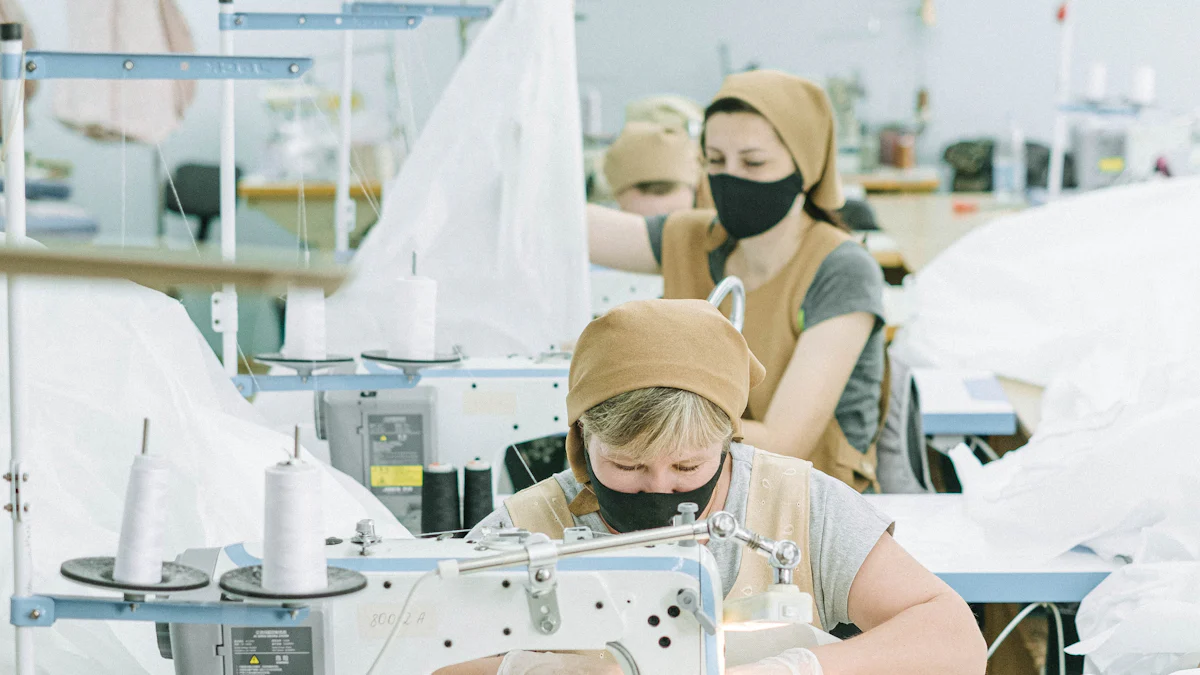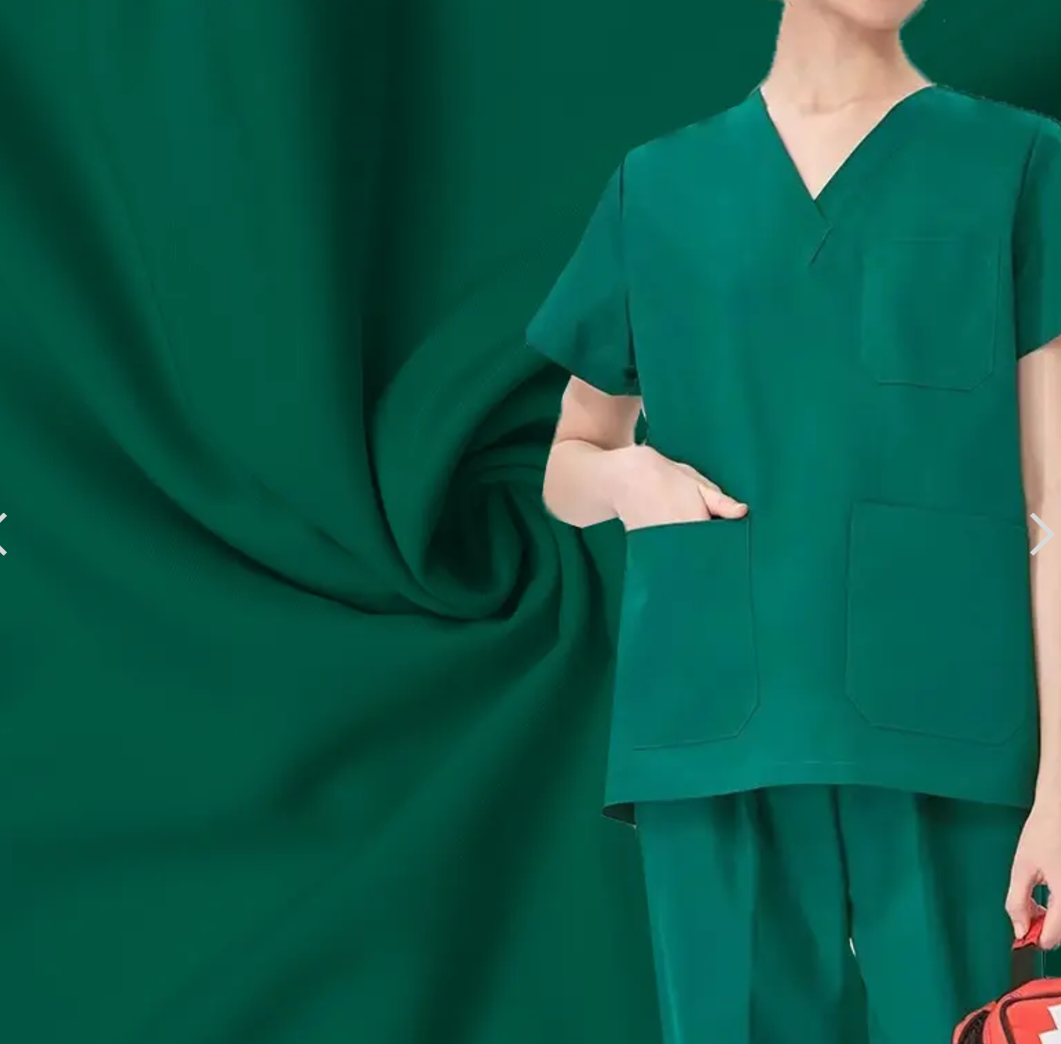- Cotton: Known for its breathability and softness, making it a popular choice.
- Polyester: Offers durability and resistance to stains.
- Rayon: Provides a soft feel and comfort.
- Spandex: Adds stretch and flexibility.
Each fabric has unique properties that cater to different needs in a medical setting. Selecting the right medical uniform fabric can enhance both comfort and performance during long shifts.
Key Takeaways
- Choose cotton for its breathability and softness, making it ideal for long shifts in high-stress environments.
- Opt for polyester if you need durability and stain resistance, as it maintains its shape and color after multiple washes.
- Consider rayon for a luxurious feel and excellent moisture-wicking properties, perfect for high-intensity work.
- Incorporate spandex into your scrubs for added flexibility and comfort, allowing for a full range of motion during demanding tasks.
- Explore fabric blends like cotton-polyester for a balance of comfort and durability, ensuring your scrubs withstand frequent washing.
- Prioritize comfort and fit when selecting scrubs, as a well-fitted uniform enhances both performance and professionalism.
- Take environmental conditions into account; lightweight fabrics like cotton are great for warm climates, while blends provide warmth in colder settings.
Common Medical Uniform Fabrics

Cotton
Properties of Cotton
I often choose cotton for its natural breathability and softness. This fabric allows air to circulate, keeping me cool and comfortable during long shifts. Its moisture-absorbent properties make it ideal for high-stress environments. Cotton's natural fibers provide a soft feel against the skin, which many healthcare professionals appreciate.
Advantages and Disadvantages of Cotton
Cotton offers several advantages. It is easy to launder and takes well to ironing, making it perfect for sanitizing scrubs. However, cotton lacks elasticity and can shrink if not handled properly. It is also prone to wrinkling, which might require extra care to maintain a neat appearance. Despite these drawbacks, cotton remains a popular choice for those who prefer natural fibers in their medical uniform fabric.
Polyester
Properties of Polyester
Polyester stands out for its durability and wrinkle resistance. This synthetic material resists stretching and shrinking, maintaining its shape even after multiple washes. I find polyester's moisture-wicking properties particularly useful in busy healthcare settings, as they help keep me dry and comfortable.
Advantages and Disadvantages of Polyester
Polyester's durability makes it a reliable choice for medical uniforms. It withstands high washing temperatures and retains its colors and prints longer than other fabrics. However, some might find polyester less comfortable than cotton due to its synthetic nature. If static buildup becomes an issue, washing with fabric softener can help. Despite these minor inconveniences, polyester remains a favored option for those seeking a durable and easy-to-care-for medical uniform fabric.
Rayon
Properties of Rayon
Rayon offers a unique combination of natural and synthetic qualities. Made from natural cellulose fibers, rayon provides a soft and smooth texture similar to silk. I appreciate its lightweight nature and excellent moisture-wicking properties, which make it suitable for high-intensity environments.
Advantages and Disadvantages of Rayon
Rayon's beautiful drape enhances the overall silhouette of scrubs, offering a flattering fit for various body types. However, rayon tends to wrinkle easily and may require more care during laundry. Despite this, its softness and comfort make it a preferred choice for those who value a luxurious feel in their medical uniform fabric.
Spandex
Properties of Spandex
I often turn to spandex when I need flexibility in my medical uniform fabric. This synthetic fiber is renowned for its exceptional elasticity. It stretches significantly and then returns to its original shape, which makes it ideal for scrubs that require a snug fit without restricting movement. Spandex blends well with other fibers, enhancing the overall comfort and fit of the garment. Its ability to stretch and recover ensures that the scrubs maintain their shape even after extended wear.
Advantages and Disadvantages of Spandex
The primary advantage of incorporating spandex into medical uniforms lies in its stretchability. This feature provides a greater range of motion, which is crucial during demanding shifts. I appreciate how spandex-infused scrubs adapt to my movements, offering both comfort and functionality. However, spandex alone lacks breathability, so it is often blended with other fabrics like cotton or polyester to improve air circulation and moisture management. While spandex enhances flexibility, it may not be as durable as other fibers, requiring careful handling to prevent damage.
Fabric Blends in Medical Uniforms

Benefits of Fabric Blends
I often find that fabric blends offer the best of both worlds when it comes to medical uniforms. By combining different fibers, these blends enhance the overall performance and comfort of scrubs. They provide a balance of breathability, durability, and flexibility, which is essential for healthcare professionals who need to move freely and stay comfortable during long shifts.
Common Blends and Their Properties
-
Cotton-Polyester Blends: This blend combines the softness and breathability of cotton with the durability and wrinkle resistance of polyester. I appreciate how this blend maintains its shape and color even after numerous washes, making it a practical choice for everyday wear.
-
Cotton-Spandex Blends: Adding spandex to cotton creates a fabric that is both soft and stretchy. This blend allows for ease of movement, which is crucial in a fast-paced medical environment. The stretchiness of spandex ensures that the scrubs fit well and move with me throughout the day.
-
Polyester-Spandex Blends: This combination offers the durability of polyester with the flexibility of spandex. I find this blend particularly useful for tasks that require a lot of bending and stretching, as it provides the necessary range of motion without compromising on durability.
Advantages of Using Blends
Using fabric blends in medical uniforms offers several advantages:
-
Enhanced Comfort: Blends like cotton-spandex provide a snug yet comfortable fit, reducing restriction and allowing for a full range of motion. This is especially beneficial for healthcare professionals who are constantly on the move.
-
Improved Durability: Blends such as cotton-polyester are known for their resilience. They withstand frequent washing and maintain their appearance over time, which is vital for maintaining a professional look.
-
Versatility: Fabric blends cater to various needs, whether it's the breathability of cotton, the stretch of spandex, or the stain resistance of polyester. This versatility makes them suitable for different working conditions and personal preferences.
Incorporating fabric blends into medical uniforms not only enhances their functionality but also ensures that they meet the rigorous demands of healthcare settings. By choosing the right blend, I can enjoy a balance of comfort, durability, and style in my medical uniform fabric.
Choosing the Right Medical Uniform Fabric
Selecting the right medical uniform fabric involves considering several factors that impact both comfort and functionality. I often weigh these factors carefully to ensure that my scrubs meet the demands of my work environment.
Factors to Consider
Comfort and Fit
Comfort and fit stand out as top priorities when choosing medical uniforms. I prefer fabrics that feel soft against my skin and allow for easy movement. Cotton and cotton blends often provide the breathability and softness I need during long shifts. Spandex blends add flexibility, ensuring that my scrubs move with me without restriction. A well-fitted uniform not only enhances comfort but also boosts confidence and professionalism.
Durability and Maintenance
Durability is crucial in medical settings where uniforms undergo frequent washing. I look for fabrics that maintain their shape and color over time. Polyester and polyester blends offer excellent durability, resisting wrinkles and stains. These fabrics withstand high washing temperatures, making them easy to maintain. The combination of cotton and polyester strikes a balance between comfort and resilience, ensuring that my scrubs last longer while retaining their appearance.
Environmental Conditions
Environmental conditions also influence my choice of medical uniform fabric. In warmer climates, I opt for lightweight and breathable materials like cotton or rayon to stay cool. For colder environments, fabric blends such as cotton-polyester provide warmth and comfort. The moisture-wicking properties of polyester help keep me dry in high-stress situations. By considering the environmental conditions, I can select a fabric that enhances my comfort and performance throughout the day.
Choosing the right medical uniform fabric requires careful consideration of these factors. By prioritizing comfort, durability, and environmental suitability, I ensure that my scrubs support me in delivering the best care possible.
Choosing the right fabric for medical scrubs is essential for comfort, functionality, and professionalism. Each fabric offers unique benefits. Cotton provides breathability, while polyester ensures durability. Rayon adds softness, and spandex offers flexibility. For long shifts, I recommend considering fabric blends like cotton-polyester for their balance of comfort and resilience. In high-stress environments, breathable fabrics like cotton or moisture-wicking materials enhance performance. By understanding these properties, healthcare professionals can select scrubs that not only look good but also support them in their demanding roles.
FAQ
What are the most durable fabrics for medical scrubs?
When I look for durability in medical scrubs, I often choose fabrics like polyester or polyester blends. These materials resist wear and tear, making them ideal for the demanding healthcare environment. Investing in high-quality materials ensures that my scrubs last longer and maintain their appearance.
Why is cotton a popular choice for medical uniforms?
I prefer cotton for its softness and breathability. This fabric keeps me comfortable during long shifts by allowing air to circulate. Cotton also doesn't build up static electricity, which adds to its appeal. Blending cotton with more durable fabrics enhances its longevity while retaining its comfort.
How do fabric blends benefit medical uniforms?
Fabric blends offer a balance of properties. For example, a cotton-polyester blend combines the breathability of cotton with the durability of polyester. This combination provides comfort and resilience, making it a practical choice for everyday wear. Blends cater to various needs, ensuring that I stay comfortable and professional.
What should I consider when choosing fabric for scrubs?
When selecting fabric for scrubs, I consider factors like comfort, durability, and color fastness. Comfort ensures that I can move freely, while durability guarantees that my scrubs withstand frequent washing. Color fastness helps maintain a professional appearance over time.
Are synthetic fabrics less breathable than natural ones?
Synthetic fabrics may offer less airflow compared to natural ones like cotton. However, they often improve moisture management. For instance, polyester is quick-drying and moisture-resistant, which helps keep me dry in high-stress situations. Choosing the right fabric depends on balancing breathability with other functional needs.
How do I ensure my scrubs remain comfortable during long shifts?
To stay comfortable, I prioritize fabrics that offer breathability and flexibility. Cotton and cotton blends provide the softness I need, while spandex blends add stretch for ease of movement. By selecting the right materials, I ensure that my scrubs support me throughout demanding shifts.
What are the advantages of investing in high-quality scrubs?
High-quality scrubs may cost more initially, but they offer greater durability and performance. Fabrics like twill and cotton blends withstand the demands of healthcare settings, ensuring longevity. By investing in quality, I save money in the long run and maintain a professional appearance.
How do environmental conditions affect fabric choice?
Environmental conditions play a significant role in my fabric choice. In warmer climates, I opt for lightweight materials like cotton or rayon to stay cool. For colder environments, blends such as cotton-polyester provide warmth and comfort. Considering these factors helps me select the most suitable fabric for my needs.
What role does fabric play in the functionality of medical scrubs?
Fabric significantly impacts the functionality of medical scrubs. Each fabric serves a purpose, whether it's polyester-spandex mixes for flexibility or cotton for breathability. By understanding these properties, I ensure that my scrubs meet the demands of my role and enhance my performance.
How can I avoid spending too much on uncomfortable scrubs?
Thorough research is essential when choosing scrubs. I explore different fabric options and consider their properties before making a purchase. By doing so, I avoid spending money on scrubs that don't meet my comfort or functional needs.
Post time: Dec-19-2024


